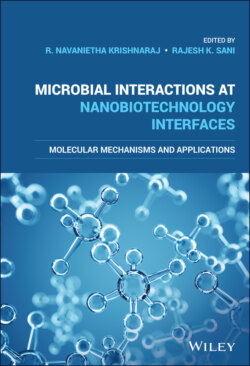Читать книгу Microbial Interactions at Nanobiotechnology Interfaces - Группа авторов - Страница 45
1.8 Interaction of NMs with Bacteria
ОглавлениеBased on the cell wall structure, bacteria are divided into two categories as Gram‐positive bacteria and Gram‐negative bacteria. Gram‐positive bacteria have a thick peptidoglycan layer ranging from 15 to 100 nm. Further, they contain a phosphate‐containing polymeric chain of teichoic acid that is responsible for the negative charge of the bacteria (Neu, 1992). In the case of Gram‐negative bacteria, an extra hydrophobic lipid bilayer is present over a thin peptidoglycan layer (20–50 nm). The presence of an extra lipid layer limits the permeability of several hydrophilic antimicrobial agents, which is the reason for the high resistant nature of Gram‐negative bacteria (Gupta, Landis, & Rotello, 2016). The negative surface charge of bacteria is due to the lipids and carbohydrates of the lipopolysaccharide layer. Hence, the structure of the bacterial cell wall determines the interaction of bacteria with NMs. Schematics of cell wall structure of Gram‐positive and Gram‐negative bacteria are given in Figure 1.3 as detailed by Hajipour et al. (2012)
In an earlier study, a homogenous distribution of cetyltrimethylammonium bromide (CTAB) coated gold NPs was observed over the Bacillus cereus. This was explained on the basis of electrostatic interaction between negatively charged teichoic acid moieties on the bacteria and positively charged gold NPs (Berry et al., 2005). In another study, it was reported that mannose functionalized gold NPs bound to the pili of Gram‐negative E. coli. It was attributed to the receptor–ligand interaction between mannose and lectin containing pili (Lin et al., 2002). Later, Hayden et al. (2012) suggested that the positively charged NMs exhibited high toxicity over bacteria. This electrostatic interaction might be a plausible reason for the spatialized aggregation of cationic and hydrophobic gold NPs on the negatively charged bacterial membrane (Hayden et al., 2012). The interaction of NPs with the membrane generally effects in membrane blebbing, tubule formation, and other membrane damage.
Figure 1.3 Bacterial cell wall structure of (a) Gram‐positive bacteria (b) Gram‐negative bacteria.
